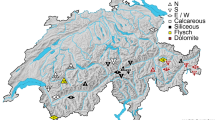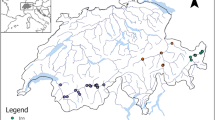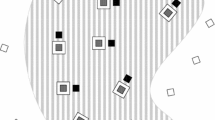Abstract
The aim was to describe spatiotemporal patterns of colonization of spruce branches by algae and lichens and the relationship with decreasing deposition of N and S. Coverage was estimated annually over 10 years for four Swedish Integrated Monitoring catchments with varying deposition levels. Initial hypotheses were that algal coverage would be positively correlated with deposition and that lichen coverage would be negatively correlated with S and positively with N deposition. Data were analyzed using regression, ANOVA, and partial least square regression. The results showed a temporal decrease in the coverage of algae but an increase in colonization rates, while lichens showed less uniform patterns. Within catchments, algae and lichen coverages were positively correlated with mainly S deposition. Across catchments, coverage of algae increased, while the coverage of lichens decreased with increasing N and S deposition. Colonization rates of both algae and lichens showed weak correlations with both spatial and temporal trends in N and S deposition. Thus, while N and S deposition had an effect on the colonization and coverage of algae and lichens, other factors are also important.




Similar content being viewed by others
References
Anon. 1998. Manual for Integrated Monitoring, compiled by im programme centre. Manual Revision group and Editorial group. http://www.environment.fi/default.asp?node=6329&lan=en. Accessed 16 Sep 2011.
Anon. 2011. Sweden’s Environment problems and protection 1960–2010. Stockholm: Swedish Environmental Protection Agency.
Atmar, W., and B.C. Patterson. 1993. The measure of order and disorder in the distribution of species in fragmented habitat. Oecologia 96: 373–382.
Bacic, T., P. Baas, and L.J.M. Van Der Eerden. 1992. Needle wax surface structure of Pinus sylvestris as affected by ammonia. Acta Botanica Neerlandica 41: 167–181.
Bobbink, R., M. Ashmore, S. Braun, and W. Flückiger. 2003. Empirical nitrogen critical loads for natural and semi-natural ecosystems: 2002 update. Background document for expert workshop on empirical critical loads for nitrogen on (semi-) natural ecosystems. In Empirical critical loads for nitrogen, eds. B. Achermann and R. Bobbink, 43–170. Berne: Swiss Agency for the Environment, Forests and Landscape.
Bråkenhielm, S. 1990. Vegetation monitoring in the PMK reference areas. Activity report of 1990. Stockholm: Swedish Environmental Protection Agency.
Bråkenhielm, S., and L. Qinghong. 1995. Spatial and temporal variability of algal and lichen epiphytes on trees in relation to pollutant deposition in Sweden. Water, Air, and Soil pollution 79: 61–74.
Carignan, V., and M.-A. Villard. 2002. Selecting indicator species to monitor ecological integrity: A review. Environmental Monitoring and Assessment 78: 45–61.
Cristofolini, F., P. Giordani, E. Gottardini, and P. Modenesi. 2008. The response of epiphytic lichens to air pollution and subsets of ecological predictors: A case study from the Italian Prealps. Environmental Pollution 151: 308–317.
Dettki, H., P. Klintberg, and P. Esseen. 2000. Are epiphytic lichens in young forests limited by local dispersal. Ecoscience 7: 317–325.
Ellis, C.J., and B.J. Coppins. 2010. Integrating multiple landscape-scale drivers in the lichen epiphyte response: Climatic setting, pollution regime and woodland spatial-temporal structure. Diversity and Distributions 16: 43–52.
Esseen, P.-A., and K.-E. Renhorn. 1996. Epiphytic biomass in managed old-growth boreal forests: Effect of branch quality. Ecological Applications 6: 228–238.
Esseen, P.-A., and K.-E. Renhorn. 1998. Edge effects on an epiphytic lichen in fragmented forests. Conservation Biology 12: 1307–1317.
Fenn, M.E., S. Jovan, F. Yuan, L. Geiser, T. Meixner, and B.S. Gimeno. 2008. Empirical and simulated critical loads for nitrogen deposition in California mixed conifer forests. Environmental Pollution 155: 492–511.
Geiser, L.H., S.E. Jovan, D.A. Glavich, and M.K. Porter. 2010. Lichen-based critical loads for atmospheric nitrogen deposition in Western Oregon and Washington Forests, USA. Environmental Pollution 158: 2412–2421.
Göransson, A. 1990. Alger, lavar och barruppsättning hos unggranar längs en kvävegradient från Sverige till Holland: en pilotstudie. In Report, Swedish Environmental Protection Agency 3741 (in Swedish). Stockholm: Naturvårdsverket
Gries, C. 1996. Lichens as indicators of air pollution. In Lichen biology, ed. T.H. Nash III, 240–254. Cambridge: Cambridge University Press.
Hänninen, O., J. Ruuskanen, and J. Oksanen. 1993. A method for facilitating the use of algae growing on tree trunks as bioindicators of air quality. Environmental Monitoring and Assessment 28: 215–220.
Hauck, M. 2010. Site factors controlling epiphytic lichen abundance in northern coniferous forests. Flora—Morphology, Distribution, Functional Ecology of Plants 206: 81–90.
Hawksworth, D., and F. Rose. 1970. Qualitative scale for estimating sulphur dioxide air pollution in England and Wales using epiphytic lichens. Nature 227: 145–148.
Hilmo, O. 1994. Distribution and succession of epiphytic lichens on Picea abies branches in a boreal forest, Central Norway. The Lichenologist 26: 149–169.
Hoffmann, L. 1989. Algae of terrestrial habitats. The Botanical Review 55: 77–105.
Hultengren, S., P.-O. Martinsson, and J. Stenström. 1991. Lavar och Luftföroreningar—Känslighetsklassning och indexberäkning av epifytiska lavar. Naturvårdsverket Rapport 3967.
Hultengren, S., H. Gralén, and H. Pleijel. 2004. Recovery of the epiphytic lichen flora following air quality improvement in south-west Sweden. Water, Air, and Soil pollution 154: 203–211.
Jeran, Z., T. Mrak, R. Jacimovic, F. Batic, D. Kastelec, R. Mavsar, and P. Simoncic. 2007. Epiphytic lichens as biomonitors of atmospheric pollution in Slovenian forests. Environmental Pollution 146: 324–331.
Johansson, O., A. Nordin, J. Olofsson, and K. Palmqvist. 2010. Responses of epiphytic lichens to an experimental whole-tree nitrogen-deposition gradient. New Phytologist 188: 1075–1084.
Krupa, S.V. 2003. Effects of atmospheric ammonia (NH3) on terrestrial vegetation: A review. Environmental Pollution 124: 179–221.
Larsen Vilsholm, R., P.A. Wolseley, U. Søchting, and P.J. Chimonides. 2009. Biomonitoring with lichens on twigs. The Lichenologist 41: 189–202.
Liska, J., and T. Herben. 2008. Long-term changes of epiphytic lichen species composition over landscape gradients: An 18 year time series. The Lichenologist 40: 437–448.
Liu, Q., and S. Bråkenhielm. 1995a. Response of epiphytic lichens and algae to sulphur and nitrogen deposition—Separation of signal from noise. In Acid regin ’95?, eds. P. Grennfelt, H. Rodhe, E. Thörnelöf, and J. Wisniewski. Dordrecht: Kluwer.
Liu, Q. 1997. Variation partitioning by partial redundancy analysis (RDA). Environmetrics 8: 75–85.
Liu, Q., and S. Bråkenhielm. 1995b. A statistical approach to decompose ecological variation. Water, Air, and Soil pollution 85: 1587–1592.
Löfgren, S., M. Aastrup, L. Bringmark, H. Hultberg, L. Lewin-Pihlblad, L. Lundin, G. Pihl Karlsson, and B. Thunholm. 2011. Recovery of soil water, groundwater and runoff from acidification at the Swedish Integrated Monitoring sites. Ambio. doi:10.1007/s13280-011-0207-8.
Marti, J. 1983. Sensitivity of lichen phycobionts to dissolved air pollutants. Canadian Journal of Botany 61: 1642–1653.
Nilsson, J., and P. Grennfelt (eds.). 1998. Critical loads for sulphur and nitrogen. Copenhagen: Nordic Council of Ministers.
Økland, R.H. 1990. Vegetation ecology: theory, methods and applications with reference to Fennoscandia. Sommerfeltia Supplements 1: 1–233.
Peveling, E., H. Burg, and K.B. Tenberge. 1992. Epiphytic algae and fungi on spruce needles. Symbiosis 12: 173–187.
Poggio, L. 2002. Epiphytic algae on Norway spruce needles in Sweden: Geographical distribution, time-trends and influence of site factors. Uppsala: Sveriges lantbruksuniveristet.
Poikolainen, J., M. Kuusinen, K. Mikkola, and M. Lindgren. 1998a. Mapping of the epiphytic lichens on conifers in Finland in the years 1985–1986 and 1995. Chemosphere 36: 1073–1078.
Poikolainen, J., H. Lippo, M. Hongisto, E. Kubin, K. Mikkola, and M. Lindgren. 1998b. On the abundance of epiphytic green algae in relation to the nitrogen concentrations of biomonitors and nitrogen deposition in Finland. Environmental Pollution 102(Suppl. 1): 85–92.
Skye, E. 1979. Lichens as biological indicators of air pollution. Annual Review of Phytopathology 17: 325–341.
Søchting, U. 1997. Epiphyllic cover on spruce needles in Denmark. Annales Botanici Fennici 34: 157–164.
Sparrius, L.B. 2007. Response of epiphytic lichen communities to decreasing ammonia air concentrations in a moderately polluted area of The Netherlands. Environmental Pollution 146: 375–379.
Thomsen, M.G. 1992. Epifyttisk belegg på barnåler i Norge i relasjon til nitrogendeposisjon og klima. Rapport Skogforsk 23, 1–11 (in Norwegian with English summary).
Umetrics, 2009. Simca-P+ 12. User guide and tutorial. Umeå, Sweden.
van Dobben, H.F., and C.J.F. ter Braak. 1998. Effects of atmospheric NH3 on epiphytic lichens in the Netherlands: the pitfalls of biological monitoring. Atmospheric Environment 32: 551–557.
van Dobben, H.F., and C.J.F. ter Braak. 1999. Ranking of epiphytic lichen sensitivity to air pollution using survey data: a comparison of indicator scales. The Lichenologist 31: 27–39.
van Herk, C.M. 1999. Mapping of ammonia pollution with epiphytic lichens in the Netherlands. The Lichenologist 31: 9–20.
van Herk, K. 2004. A changing lichen flora. In Lichens in a changing pollution environment. English Nature Research Reports eds. Lambley, P., Wolseley, P., English Nature, pp. 13-20.
van Herk, C.M., E.A.M. Mathijssen-Spiekman, and D. de Zwart. 2003. Long distance nitrogen air pollution effects on lichens in Europe. The Lichenologist 35: 347–359.
Wolseley, P.A., and K.V. Pryor. 1999. The potential of epiphytic twig communities on Quercus petraea in a Welsh woodland site (Tycanol) for evaluating environmental changes. The Lichenologist 31: 41–61.
Acknowledgments
Sven Bråkenhielm, Lage Bringmark and Staffan Åkerblom and Tommy Pettersson are thanked for inventories. The monitoring program is financed by the Swedish Environmental Protection Agency. Brendan McKie and anonymous reviewers gave valuable comment on the manuscript.
Author information
Authors and Affiliations
Corresponding author
Rights and permissions
About this article
Cite this article
Grandin, U. Epiphytic Algae and Lichen Cover in Boreal Forests—A Long-Term Study Along a N and S Deposition Gradient in Sweden. AMBIO 40, 857–866 (2011). https://doi.org/10.1007/s13280-011-0205-x
Published:
Issue Date:
DOI: https://doi.org/10.1007/s13280-011-0205-x




